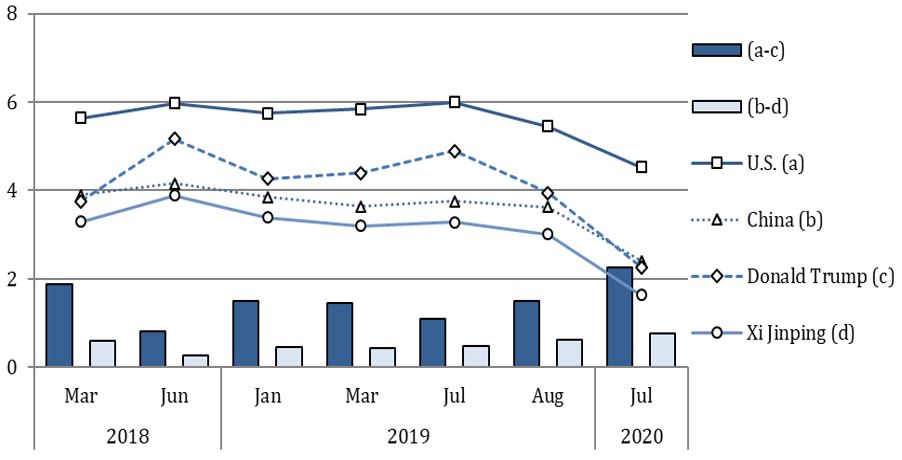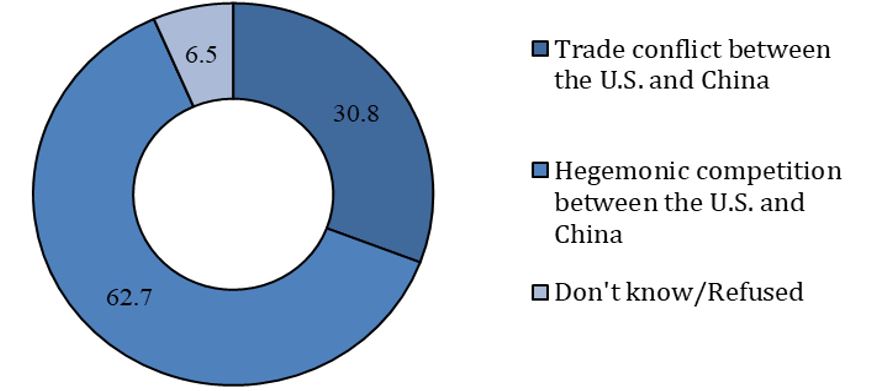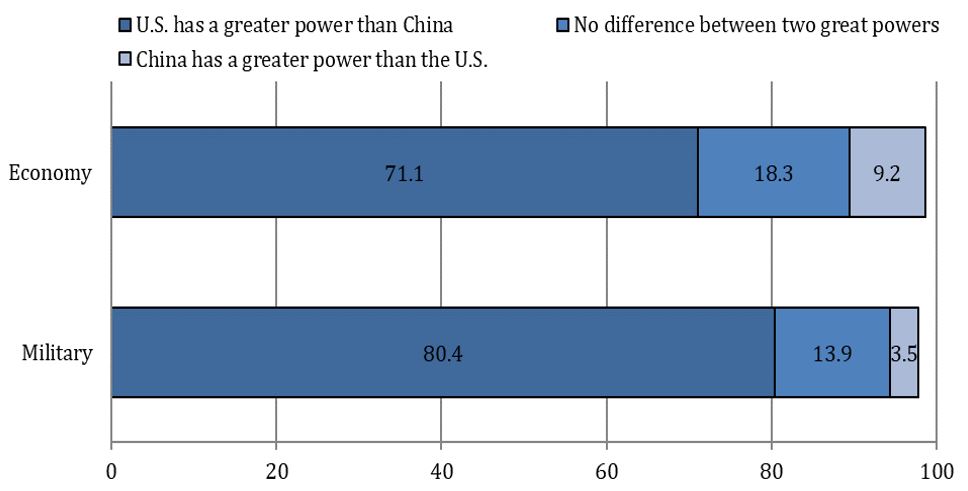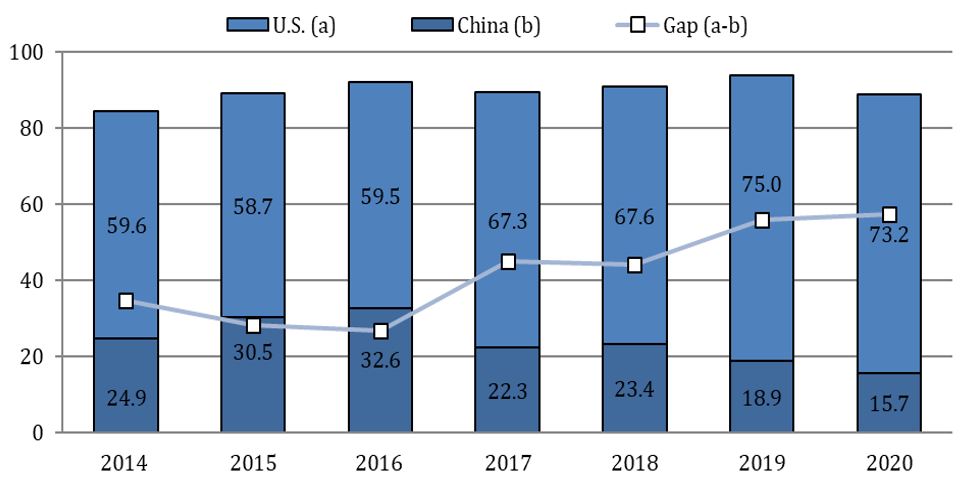Introduction
As a number of observers have pointed out, Seoul’s position between Washington and Beijing is becoming more precarious as tension continues to escalate between the U.S. and China. One recent study, for instance, reports that nearly 35% of South Koreans perceive the U.S.-Sino competition as a “threat to South Korea’s national interest” and more than 6 in 10 South Koreans prefer a more “balanced approach.”1 Other studies, however, suggest that South Korean public opinion on this issue is less ambiguous with a strong preference for strengthening the alliance with the U.S. even though a majority of South Koreans expect China to be the more influential regional player in the next ten years.2
This issue brief seeks to build on existing studies about South Korean attitudes on U.S.-China competition. In particular, we explore how South Koreans view the nature of the U.S.-China relationship and what they believe is the choice that South Korea should make if Seoul is forced to choose between the U.S. and China. The findings show that there is a decline in the overall favorability of the United States (5.45→4.52) and China (3.63→2.40) as well as their respective leaders (Trump: 3.95→2.26, Xi Jinping: 3.01→1.63). But when presented with a binary choice, the South Korean public clearly favors the U.S. (73.2%) over China (15.7%). The findings also show that the South Korean public thinks that the balance of power is tilted in favor of the U.S. (economy 71.1%, military 80.4%) but they also acknowledge that this may change in the future. Finally, the Korean public is quite disappointed in the lack of leadership that these two countries have shown on the global stage (U.S.: positive 45.2%, negative 48.2%; China: positive 18.1%, negative 79.6%).
Relative Favorability
The baseline sentiment about the U.S. and China can best be gauged by examining their relative favorability. But in doing so, it is important to not lose sight of the context under which these attitudes are being measured. In particular, there are two major developments that would negatively impact South Korean public attitudes about the U.S. and China.
One is the COVID-19 pandemic. Much has been made about the lack of information from China as well as the restrictions placed on travelers from South Korea into the U.S. and China. For instance, the U.S. imposed the highest travel alert on South Korea as of March 31 for civilian travel. U.S. armed forces personnel were suspended from traveling to and from South Korea as of March 8. During a press conference on February 4, the Chinese ambassador to South Korea stated that South Korea should “make its decision based on science and WHO recommendation.”3 The Chinese government locked down Wuhan as of January 23 and foreigners from South Korea were banned from entering China as of March 28. South Korea, however, never imposed any travel ban on either the U.S. or China except for the restriction imposed on residents of Hubei Province. South Korea has complained about the double standard that Beijing had imposed on South Koreans entering mainland China and Chinese nationals entering South Korea.
The second important factor is the U.S. demand for higher contribution from South Korea towards U.S. troop basing in the Korean Peninsula. While South Korea has increased the share of its contribution for the costs associated with basing U.S. Forces in Korea (USFK) for 2019, the two countries have yet to strike a new deal for 2020 and beyond. The latest statements coming from high ranking officials in Washington, including President Trump, is the possibility of U.S. troop reduction from South Korea. Recent move by the U.S. to reduce troop presence in Germany have raised some concerns in South Korea as well.4 Pressuring the South Korean administration to provide more financial support for the USFK is highly unpopular across a broad spectrum of the South Korean society.5
Figure 1. Favorability toward the U.S. and China6 (0~10 point)
For all of these reasons, it is not at all surprising to find a significant decline in favorability of the U.S. and China among South Koreans. When respondents are asked to rate the U.S. and China on a scale of zero to ten (0= “not favorable at all”, 10= “most favorable”), the U.S. records an average score of 4.52 in July 2020. China is 2.4. Although the figure is higher for the U.S., it is a record low since the question was first measured in 2013. As far as the leaders are concerned, Xi Jinping is 1.63 while Donald Trump is 2.26. When compared over time, all of these figures are significantly lower from that of 2019 (U.S.: 5.45→4.52, China: 3.63→2.40, Xi Jinping: 3.01→1.63, Trump: 3.95→2.26; See Figure 1).
When it comes to the linkage in South Korean attitudes about these two countries and their respective leaders, there is greater convergence for China than for the U.S. More specifically, we find a noticeable divergence in public assessment about the U.S. and President Trump (|a-c|= 2.26, See Figure 1). What this suggests is that the South Korean public is sophisticated enough as to make a distinction between the U.S. and President Trump. However, the same is not the case for China and Xi Jinping. In fact, what we see is a high degree of correlation in the favorability rating for China and its leader (|b-d|≤ 0.77, See Figure 1). What this suggests is that the South Koreans do not see much difference between China and President Xi.
Trade vs. Power Competition
It is important to consider the South Korean perception about the nature of the competition between the U.S. and China. Do South Koreans see this conflict as being limited to trade and commerce? Or do they see it as a broader struggle for regional or global hegemony?
Depending on how South Koreans answer these questions, the South Korean approach to managing the U.S.-Sino conflict may be different. For instance, if South Koreans see this competition as being largely limited to trade, then they need not consider taking sides on issues related to other matters, such as those dealing with universal values (i.e. democracy or human rights) or national security (i.e. South China Sea or North Korea). Instead, South Korea will have to focus its attention on finding a way to navigate the uneasy trade relations between the U.S. and China.
If, however, the South Koreans perceive the U.S.-Sino relations as being a competition for hegemonic control, they are more likely to consider the broader implications of this conflict and how they stand on matters like Hong Kong, Xinjiang, Tibet, and Taiwan as well as Chinese Sharp Power, trade, technology, among other matters.
Figure 2. Views on the U.S.-China Competition7 (%)
When asked how they would characterize the competition between the U.S. and China, a large majority said that they see it as a hegemonic competition (62.7%). A little over 30% see the conflict as one that is restricted to trade (Figure 2).
South Koreans also seem to have a rather pessimistic outlook on U.S.-China relations. When asked whether they thought that the U.S.-Sino rivalry will get better or worse, more than half (56.8%) of the respondents answered that they expect it to get worse. 31.4% said that relations will improve and only 8.2% state that the relationship will not change.
Balance of Power
One of the debates surrounding the U.S.-Sino rivalry is the outlook on the regional balance of power. Some observers draw parallels between South Korea’s choice among the U.S. and China with Joseon’s choice among the Ming and Qing during the early 17th century.8
There is little debate about China’s accomplishments over the past 40 years. Since its opening in the late 1970s, China’s per capita income (PPP) grew by nearly 65 times and its share of global GDP increased from 1.8% in 1979 to over 19% today. China’s total output today is over USD 13 trillion, second only to the United States, which stands at about USD 20 trillion. During this period, poverty in China decreased from 88% to less than 1% and average life expectancy grew from 66 to 76. The OECD expects China to continue growing until 2030 when its share of world output would peak at 27%.9
But how do South Koreans view the current status and future trajectory of great power distribution in the region? The data suggests that the South Koreans have an informed view on this matter. When asked about the current status, over 80% of South Koreans agree that the U.S. holds a significant military advantage over China. A negligent minority seems to believe that China (3.5%) holds the edge. Nearly 14% said they do not see a difference (Figure 3).
Figure 3. Balance of Power10 (%)
Over 71% agree that the U.S. is the largest economy in the world. A little over 9% see China as the world’s leading economy. 18.3% state that they do not see a significant difference between the two.11 This finding is consistent with the results from a recent study in the U.S. where a majority of Americans thought that the U.S. is the world’s leading economic (59%) and military power (83%).12
Future outlook, however, is more divided with only 43.2% of South Koreans seeing the U.S. maintaining this edge. 34.7% think that China would be able to achieve parity in the next decade. It is interesting that about 18.9% see China overtaking the U.S.. The diverging outlook among the South Korean public is understandable given that there is disagreement even among experts as to China’s potential to overtake the United States as a dominant power.13 But for the time being, only a small minority of the South Korean public is convinced that China will be able to surpass the United States.
Partnership and Global Leadership
Despite holding a precarious outlook, when South Koreans are asked to take a side between the U.S. and China, South Koreans have steadfastly favored the former over the latter. When asked to choose which country South Korea should strengthen its ties with if the U.S.-China rivalry continues, more than seven-in-ten chose the U.S. (Figure 4). What is striking about this finding is that the preference for the U.S. is gaining momentum even though the outlook on U.S. regional influence and ROK-U.S. bilateral relations are challenged. The data also shows a decline in preference for China and a growing gap between the U.S. and China, which dates back to 2017.
Figure 4. South Korea’s Future Partner14 (%)
There are several explanations for this. One is the context under which these attitudes are being shaped. The ROK-China relations have undergone significant change since North Korea conducted its fourth nuclear test in January 2016. President Xi Jinping failed to respond to requests for dialogue on this matter by then-President Park Geun-hye.15 When South Korea decided to address the growing North Korean nuclear threat by announcing the deployment of the Terminal High Altitude Area Defense (THAAD) system in the Korean Peninsula during July 2016, China’s response was economic pressure. Even though President Moon has tried to revive the ROK-China relations with a trip to Beijing in December 2017, China has not changed its policy towards South Korea.16 For the South Korean public, Chinese reaction to these series of events are infringements on South Korean sovereignty and national security.17
The second explanation is the long-standing alliance that South Korea maintains with the U.S. It is an open secret that the ROK-U.S. relations has been challenged under the current leadership in Seoul and Washington. It is important to recognize, however, that the alliance has a long history which dates back to the Korean War. There have been twelve presidents in Washington since the Mutual Defense Treaty was signed in 1953 and the ROK-U.S. alliance has undergone numerous changes during that time. In fact, this relationship has remained robust, if not evolved to incorporate a number of new dimensions.18 It is difficult to imagine a scenario where this relationship will come to an abrupt end due to growing tension between Washington and Beijing. If anything, the data seems to suggest a greater willingness in South Korea to stand with the U.S. in this struggle.
Finally, it is important to not lose sight of the South Korean perspective on the role that these two countries play on the global stage. In general, South Koreans have expressed dissatisfaction with the lack of global leadership. When asked to assess the U.S. leadership on the global stage, 60.8% is negative and 37% said it is positive. This is a reversal from 2015 when 72.4% of South Koreans were positive about the U.S. leadership and 22.3% were negative. South Korean view of China’s role as a world leader also underwent significant change as 79.6% state that China does not perform well as a leader. Only 18.1% are positive. In 2015, 52.1% of the surveyed respondents saw China’s leadership performance as being positive and 40.9% stating that it was negative.
The result is understandable. The escalating rivalry between China and the U.S. directly impacts South Korea’s national interest as these two countries are South Korea’s two largest trade partners. For instance, the recent decision to require global chipmakers using U.S. technology to obtain a license from the U.S. government to work on product designs for Chinese technology companies directly impacts major South Korean companies like Samsung and SK Hynix. The recent coronavirus outbreak and its handling by both the U.S. and China also did little to raise these two countries’ standing within the international community. Instead of showing leadership, both countries worked to escalate tension and gain strategic leverage. The U.S. under the Trump presidency has worked to dissociate itself from international organizations, such as the World Health Organization (WHO), UN Educational, Scientific and Cultural Organization (UNESCO), and UN Human Rights Council (UNHRC). The U.S. also withdrew its commitment from the Paris Climate Agreement, Trans-Pacific Partnership, and JCPOA. Meanwhile, China has continued to violate the United Nations Convention on the Law of the Sea (UNCLOS) with its claim to the South China Sea. Beijing has made its intentions clear in how it will manage its affairs in Hong Kong, Xinjiang, and Tibet. The uneasy bilateral relationship that Seoul has maintained with Washington and Beijing since 2016 also appears to have impacted the South Korean views about the U.S. and China.
Table 1. Global Leadership: U.S. vs. China19 (%)
However, the outlook that the South Korean public has about the future role of the U.S. on the global stage is decidedly more positive (Table 1). When asked about the U.S. performance as a global leader ten years from now, 45.2% is positive and 48.2% view it as negative. This is a marked contrast from the Korean public outlook on China’s future performance as a leader, which is 62.1% pessimistic and 33.5% optimistic. These results suggest that a larger share of the South Korean public is more optimistic about the likelihood that the U.S. will reassume its role as a leader while a larger majority is skeptical about China’s ability to do the same.
Conclusion
Our recent survey of the South Korean public shows a decline in the overall standing of the U.S. and China with record-low favorability ratings for both countries and their respective leaders in July 2020. South Korean public is also negative about the lack of leadership that these two countries have shown on the global stage. However, when presented with a choice, the South Korean public clearly favors the U.S. over China. The data also suggests that the South Korean public sees the balance of power tilted in favor of the U.S. over China, but they also recognize that this may not be the case in the future.
What our recent survey suggests is that there are political implications to the policy choice that South Korea may make with respect to the U.S.-Sino rivalry. The political implications of this choice may be less meaningful in a non-election year, but the long-term impact is likely to be consequential. While it may be true as some studies suggest that South Korea would prefer a more balanced approach to relations with the U.S. and China, the South Korean public clearly favor the U.S. over China; therefore, any decision to move against the long-standing alliance with the U.S. would not have popular support.
From a policy standpoint, South Korea should not shy away from taking a more proactive stance on U.S.-China competition. Regardless of the U.S. presidential election this coming November, U.S.-China relations is likely to undergo significant change. Instead of staking out an ambiguous position in between these two great powers, South Korea can do better by using the current situation as an opportunity to identify a more sustainable and forward-looking policy based on norms, principles and values, which South Korean public seems to support as the data suggests. It requires a more sophisticated engagement with both sides and a more in-depth understanding of the future U.S. policy towards China. Instead of avoiding the topic of choice between the U.S. and China, South Korea would be able to better define its interest by inviting frank debates and discussions about the benefits and costs of its relationship with these two countries.
Survey Methodology
Asan Survey
Sample Size: 1,000 respondents over the age of 19
Margin of Error: ±3.1% at the 95% confidence level
Survey Method: Random Digit Dialing (RDD) for mobile and landline phones
Period: See footnotes
Organization: Research & Research
The views expressed herein do not necessarily reflect the views of the Asan Institute for Policy Studies.
- 1. Sea Young Kim and Sook Jong Lee. “South Korean Perception of the United States and China: United States, a More Favorable Partner than China.” Issue Briefing. EAI. Released on July 21, 2020. See also Victor Cha. “Collateral Damage: What U.S.-China Competition Means for Korea.” CSIS. Released on October 10, 2019. Ji Young Lee. “South Korea’s Strategic Nondecision and Sino-US Competition.” Strategic Asia 2020. NBR. Released on January 21, 2020.
- 2. J. James Kim, Kang Chungku, Scott A. Snyder, and Ellen Swicord. “South Korean Caution and Concern about China.” Issue Brief. The Asan Institute for Policy Studies. Released on October 16, 2019. Karl Friedhoff, Dina Smeltz, J. James Kim, Kang Chungku, Scott A. Snyder, and Ellen Swicord. Cooperation and Hedging: Comparing U.S. and South Korean Views of China. The Chicago Council on Global Affairs and the Asan Institute for Policy Studies. Released on October 16, 2019.
- 3. Seung-woo Kang. “Chinese envoy calls for mutual cooperation on coronavirus.” The Korea Times. February 4, 2020.
- 4. Carey, G. and Capaccio, A. “US Plans to Withdraw About 12,000 Troops from Germany.” Bloomberg. Released on July 29, 2020.
- 5. Scott A. Snyder, Ellen Swicord, J. James Kim, and Kang Chungku. “South Korean Attitudes toward the U.S.-ROK Alliance and USFK.” Issue Brief. The Asan Institute for Policy Studies. Released on February 22, 2019.
- 6. Asan Survey (Mar 21~22, Jun 18~20, 2018; Jan 7~9, Mar 19~20, Jul 9~10, 2019; Jul 15~16, 2020).
- 7. Asan Survey (Jul 15~16, 2020).
- 8. Min-hee Park. “Where does South Korea’s obligation to the U.S. end?” Hankyoreh. October 12, 2017.
- 9. OECD. Economic Survey of China. Released on April 16, 2019.
- 10. Asan Survey (Mar 11~12, 2015; Jul 15~16, 2020).
- 11. According to the summated index, 64.4% evaluated the U.S. as more powerful militarily and economically. Those who chose China as having greater superiority in these areas were only 1.4%.
- 12. Devlin, K., Silver, L., & Huang, C. “U.S. Views of China increasingly negative amid Coronavirus outbreak.” Pew Research Center. Released on April 21, 2020. The percentages who agree with the statements as follows: “The U.S. is the world’s leading military/economic power.”
- 13. Xia Liping. “China: A responsible great power.” Journal of Contemporary China. 10(26): 17-25. Published on Aug 2, 2010. Paul Dibb and John Lee. “Why China Will Not Become the Dominant Power in Asia.” Hudson Institute. Nov 21, 2014.
- 14. Asan Survey (Mar 11~12, 2015; Jul 15~16, 2020).
- 15. Lee Seong-hyon. “Why Xi Jinping didn’t answer Park’s call.” The Korea Times. February 5, 2016. Shannon Tiezi. “North Korea Nuclear Test Reveals the Limits of China-South Korea Cooperation.” The Diplomat. January 14, 2016.
- 16. Charlotte Gao. “Was Moon Jae-in’s China Trip Successful?” The Diplomat. December 19, 2017.
- 17. Kim Jiyoon; John J. Lee; and Kang Chungku. “Changing Tides: THAAD and Shifting Korean Public Opinion towards the United States and China.” Issue Brief. The Asan Institute for Policy Studies. Released on March 20, 2017.
- 18. Korea Matters for America/America Matters for Korea. East West Center; the Asan Institute for Policy Studies; and Korea Institute for International Economic Policy. 2018. (https://asiamattersforamerica.org/korea).
- 19. Asan Survey (Jul 15~16, 2020).

 Facebook
Facebook Twitter
Twitter





